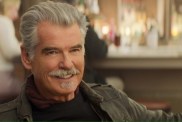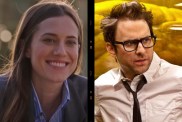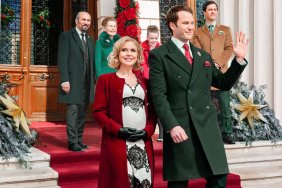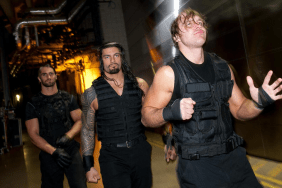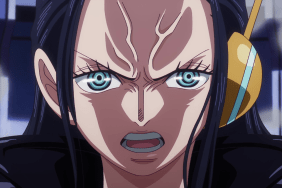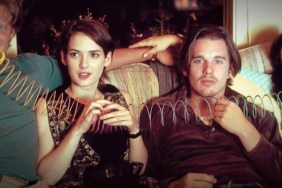As mentioned earlier, Turteltaub was very busy and we weren’t sure if we would have a chance to talk to him, but fortunately, he made time for us in between takes.
Q: How has it been shooting in New York?
Turteltaub: Well, I’ve shot here before but never even remotely to this extent. It’s been great actually. It’s not that it’s not difficult, it’s definitely difficult, but nothing is not doable. It’s like living in New York: everything is possible and nothing’s easy.
Q: Is that just Jerry (Bruckheimer) making things possible?
Turteltaub: Not even Jerry can make it possible. No, a lot of conversations and rule-following and bureaucracy to do things the right way. It’s no more difficult or easy for a Jerry Bruckheimer movie or a small independent film. New York invites people here. You got to go through what you got to go through, but when you have 22 big rig trucks – let’s put it this way, it’s hard to park a Vespa in New York, so trying to find a way to park 22 trucks is difficult.
Q: How big a fan were you of the original “Fantasia”? How nervous are you dealing with something that sacred?
Turteltaub: I was a big fan of “Fantasia.” Like most kids, I was bored by the boring parts and liked the fun parts. The (“Sorcerer’s Apprentice”) sequence I think was everyone’s favorite because there was a story and humor and real recognizable characters, not just because you recognized Mickey, but because we understood, without too much metaphor, what was going on. At least that was true when I was five. The thought of being handed an important piece of Disney pedigree is daunting. My assumption is there is no way to do it without someone being mad at me, that those who are snooty in the critical world will find a way to be snooty and critical no matter what we do. I’m trying to balance that with the opportunity to bring to life a great piece of classic cinema into an updated live-action form and to make good on the trust Disney has shown me. And then came the surprising part of it, which is as I go around telling people I’m doing “The Sorcerer’s Apprentice,” they stare at me with blank stares having no idea what I’m talking about. I’m awoken to the notion that not all people know “Fantasia” and know Mickey Mouse in “The Sorcerer’s Apprentice.” Then I go on and say, “It’s the one where he’s in the magic hat with the stars and the brooms.” Not sure why that is, and what’s funny is that it’s the single most iconic image of Mickey. That hat is at centerpiece of the Disney/MGM theme park (and) Disney Animation Studios. It’s definitely daunting. It’s something where we talked a lot about, “Do we do just a little wink toward the original or is that really not fulfilling the assignment. And we thought, “This is ‘The Sorcerer’s Apprentice.'” Let’s tell that story in a live-action form that fits our movie. So far from what we’ve shot and the effects we’re doing, I think it’s actually kind of awesome.
Q: Did anyone wear Mickey ears during the auditions?
Turteltaub: No, I can’t say they never wanted to, but no.
Q: After the “National Treasures,” this is more based in the real world in a New York context…
Turteltaub: I don’t know if it’s more based in the real world than “National Treasure.” I guess it’s always hard for a filmmaker to really know how audiences perceive the movies. We tried to make “National Treasure” as real world as possible and they were very based in the real world. That’s why they were stealing the Declaration of Independence and not a magic muffin.
Q: I’m saying, this is movie fantasy as opposed…
Turteltaub: Oh, this is more fantasy than that. Well, I don’t know. (laughs) In some ways, when you’re doing movies with magical elements, you have to try harder to keep it real. You always run the risk of losing the suspension of disbelief and taking too much advantage over magical elements so you really have to push yourself to set strict rules and stick by them so that the story and the character and the emotions are believable. If magic can solve every problem, than there are no problems. So you have to limit the amount of fantasy and magic that’s at your disposal.
Q: Would you say that you’re trying to strike the same tone as a family-friendly action adventure?
Turteltaub: I think we’re trying to attract a similar audience. I don’t like making a movie that keeps anyone away. We want kids to enjoy this movie but I want adults to enjoy this movie. I try not to make movies at the exclusion of anyone, though apparently there’s one demographic that I don’t really strike a chord with: critics. That’s a group that, I just can’t hit them. I guess I can’t escape myself in terms of tone. I can’t get out of my own way in terms of making things what I feel are genuine, human and humorous. I just don’t like movies myself where I feel the people aren’t real people, that don’t have real problems and real emotions. One of those things that keep people real is humor, and keeping humor in a movie is something I feel makes them more believable and more accessible to an audience. It’s also part of the fun. But tonally, it’s certainly different than “National Treasure.” While in some ways the stakes are bigger, the immediate jeopardy and stakes are not quite as dire and relatable as maybe “Assassination of a President” or something like that, but it’s more fun-oriented than action-oriented.
Q: Do you not think doing those first two “National Treasure” movies helped figure out the tone you needed to go for in terms of a rating?
Turteltaub: It’s weird. When we started making “National Treasure,” it was a Touchstone movie and they saw the first cut and they said, “This isn’t a Touchstone movie, this is a Disney movie.” I think I’m the only director in Hollywood whose cut is cleaner and shorter than the studio release. It just felt tonally right. It’s just a tone I enjoy, the tone I got out of the movies I saw growing up. I never find myself having to find myself having to censor myself to make a Disney film. You just start with the subject matter that’s right and feeling that’s right and the characters that are right. Good people who are your characters tend not to take their clothes off for no reason and things like that. So it’s not really tricky. Every now and then, there’s a really awesome joke that gets left on the cutting room floor because it doesn’t quite fit. Disney now does make PG-13 movies. Jerry and “Pirates” broke that barrier. They were thinking that “National Treasure 2” might be a PG-13, and it just wasn’t. I’m too big of a wuss. For this, it definitely will be family friendly. Maybe I’m just naive, but I don’t think people pay as much attention to ratings as ratings boards and studios do. I think people go to movies they hear are good. Someone says, “Oh, it’s good. You should see it.” And then you go. And you check the rating if you have a kid. If it’s rated R or PG-13, you think, “Oh, my little kid can’t go.” A teenager doesn’t go, “It’s PG, let’s not go.” They heard it’s good, they go.
Q: Jay hasn’t really had this sort of leading man role. What was it about him that made you think this could be his big breakout?
Turteltaub: You always, always, always as a director want to cast the best person for the part. The list of big movie stars who are college-aged who can be super smart and funny and hilarious – it’s not a huge list. There’s no problem finding somebody who might be a little less known. Jay has an extraordinary sense of humor. His comic timing is brilliant. (sees Alfred Molina approaching) He’s no Fred Molina. Let’s not get crazy. He’s amazingly inventive. Jay is sort of a bizarre cross between Lenny Bruce and Jerry Lewis. He’s very politically-minded and brilliant but amazing with physical comedy and loves to laugh.
Q: We heard he has a filthy mouth, too.
Turteltaub: Well, yeah, it’s true. A comedian’s adlibs tend to not always be appropriate for family viewing, but that’s why God invented editors.
Q: Would you ever want to do an R-rated Disney movie?
Turteltaub: You remember the first R-rated Touchstone movie? First R-rated movie Disney made… It’s weird. When you start, you have an image of a movie and an actor and a character and you’re casting and you never really get the person you think you going to get, and then by the time you’re done, you can’t even remember what you think you wanted at the beginning. It just ends up being that. So at this point, I don’t remember a version of this movie in my head that didn’t have Jay in it. Oddly, Nic is the one who approached me and hired me for this movie. On “National Treasure,” Nic came in and met with us and we had to decide, “Is that the guy we want?” On this movie, Nic hired me. Nic is in some ways my boss on this movie. It wasn’t an issue if Nic was right for the part. I only saw Nic because when I read the script, it was Nic. I actually think this is one of the best fits in Nic’s career. This character just fits so well with Nic’s performance style, his acting style. It just gives him the chance to play such a huge range, and it’s sort of Nic-like in that it’s unpredictable, it’s a little bit off the wall, but also a little bit Zen and spiritual. Very romantic, and that’s Nic.
Q: When you got the script and you saw things like “the Chrysler eagle comes to life,” do you wonder, “How am I going to do this stuff”?
Turteltaub: Some of it I read and thought I had no idea how this is done even though other people have done it in movies so I’m scared. Other parts, I read I do, “I have no idea how this is done but I know it can be done, so whatever.” Other parts you read and go, “I know this is too expensive and I don’t have time for this.” It’s funny, the simpler, cheaper, easier way. But most of the effects, I come to from the standpoint of, “Is this helping our story or not? Is it just an effect for effects sake? Is this in keeping with the tone of the movie?” I know tone was brought up before. To me, tone is almost everything. An audience almost smells and feels a movie. They like being in the world of that movie. How you get there, how you create that tone, I’m not totally sure. I think it’s why some movies work and some don’t, and the tone is somehow right for some people. You go through the effects the same way. You go, “Cool, Chrysler eagle, but uncool, 500 shots of an eagle flying around New York.” You’re planning all that as you go and figuring all that out. The fear is you’re always going to undersell and not do enough visual effects to make it a big enough movie. But my fear is always the opposite. My fear is always overdoing that–and I’m sure every director says the same thing–but it’s not the movie. It’s just another tool to tell your story and help connect with the characters. No question, cool effects are cool. You see a movie like “Transformers” and it’s a fantastic spectacle. In a weird way, I feel like I’m not good enough at doing that to rely on that, so I’d better get the characters right and the drama right and make sure the effects don’t eff that up.
Turteltaub headed back briefly to the fountain to check something before joining us again briefly for another couple questions.
Q: How many things are going through your mind and how fast do the days go when you’re doing a picture this big?
Turteltaub: The days go quickly, the nights go slowly. I’ll look at my watch and go, “It’s only 2 a.m. I have to do three more hours.” I don’t think a director is ever bored. That’s one great thing about this job. There’s not a moment you’re bored, but that’s most because all those little moments are filled with anxiety and stress. There’s the panic that making sure that shot you’re shooting is doing what it needs to do and on something like this, there are so many moving parts, with flying things and visual effects, and am I paying enough attention to performance, does the hair look good. As soon as you get a shot step up, in some ways you’re already thinking about the next shot. And you can’t not be thinking about your schedule. You got to make your night. It’s not about the best–and this is going to sound pathetically inartistic–but the truth about making movies is not about making the best movie. It’s about making the best movie within the parameters you have. You guys deal with it too. You don’t write the best article ever. You write the best piece with the number of words you’re given, with the space, and you go in, “I got a great story. This director’s so funny and he’s great.” “Eh, it was Nic’s stuff.” It’s the same thing… You want to just make the best movie you can for the money, for the time, for the space, with the abilities of the people and some people are better at other things. You just do the best you can.
Q: So you never look at your old pictures and go, “Oh, I could have done this better.”
Turteltaub: I do, and sometimes I look at it and think literally, “What was I thinking? Why wasn’t the camera three feet to the left and that would have been perfect? And why did I have Sandra Bullock say it that way?” And all of that stuff. More often than not, I look at them and say, “Oh, that was better than I thought. Why aren’t I doing that still?”

